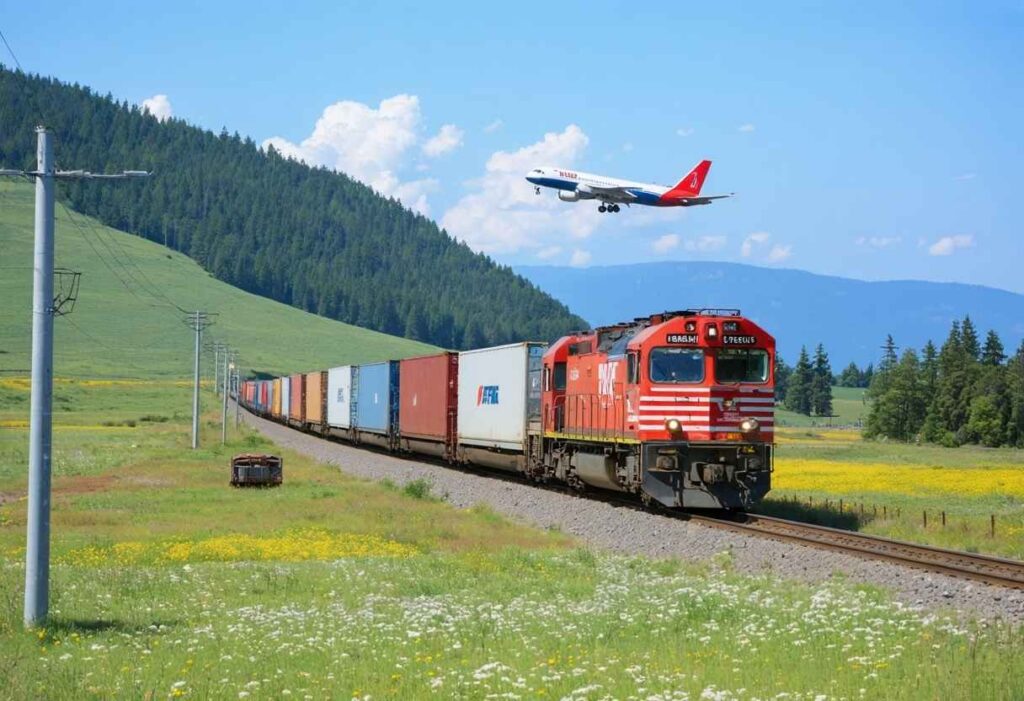- By Della tj
- October 16, 2025
- Sea Freight, Shipping
Efficient trade between China and Italy depends on balancing speed, cost, and reliability. While air freight is quick but expensive, and rail is limited, fast sea freight from China to Italy offers the best compromise. It enables importers to shorten transit times without losing cost efficiency — making it an essential logistics solution for 2025’s global supply chain.
Why Choose Fast Sea Freight from China to Italy
Fast sea freight services combine priority scheduling, direct port routes, and optimized customs processing. Unlike regular ocean shipping, these services minimize idle port time and reduce total delivery duration.
Importers benefit from:
- Faster transit (25–28 days) from major Chinese ports
- Lower shipping costs compared with air freight
- High reliability with weekly departures and real-time tracking
Moreover, the improved frequency and coordination between Chinese and Italian ports ensure steady cargo flow even during peak seasons.
Main Shipping Routes and Average Transit Times
The following table shows the most efficient trade routes between major Chinese and Italian ports:
| Route | Departure Port | Arrival Port | Transit Time | Service Type |
|---|---|---|---|---|
| Shanghai → Genoa | Shanghai | Genoa | 25 days | Direct Express |
| Ningbo → Venice | Ningbo | Venice | 27 days | Transshipment |
| Shenzhen → Trieste | Yantian | Trieste | 24 days | Fast Line |
| Qingdao → Naples | Qingdao | Naples | 28 days | Regular Route |
These express routes are supported by carriers such as MSC, COSCO, and Maersk, ensuring shorter lead times and stable schedules.
Freight Rate Comparison and Cost Insights
Shipping costs depend on container type, cargo size, and fuel surcharges. Below is a cost comparison across various transport modes:
| Shipping Mode | Avg. Transit Time | Cost (per CBM) | Ideal Cargo Type |
|---|---|---|---|
| Fast Sea Freight | 25–28 days | $1.8–$2.5 | General goods, electronics |
| Regular Sea Freight | 35–40 days | $1.3–$1.9 | Bulk cargo |
| Air Freight | 5–7 days | $6–$10 | High-value, urgent goods |
| Rail Freight | 18–22 days | $3–$4 | Light industrial products |
Although air freight is quicker, fast sea freight from China to Italy provides a 40–60% cost reduction with reasonable speed.
Key Ports and Their Advantages
China’s major export ports:
- Shanghai – High capacity, frequent direct sailings
- Ningbo – Efficient consolidation hub
- Shenzhen (Yantian) – Advanced customs clearance
- Qingdao – Strong for North China exports
Italy’s main import ports:
- Genoa – Ideal for northern Italy distribution
- Venice – Strategic access to Central Europe
- Trieste – Shortest rail connection to Germany
- Naples – Best for southern market access
Each port offers customs digitalization, warehouse integration, and inland logistics for smoother supply chain management.
Real Case Studies: From China to Italy
Case 1: Furniture from Foshan to Milan (via Genoa)
Mode: 1×40HQ Container, Fast Sea Freight
Transit Time: 25 days
Total Cost: USD 3,200 (all-inclusive)
Result: Retailer met launch date without delay, saving 35% vs. air freight.
Case 2: Electronics from Shenzhen to Trieste
Mode: FCL, 25 tons
Cost: USD 2,800
Transit: 24 days
Outcome: Supply chain cycle reduced by one week, improving turnover speed.
Customs Clearance and Required Documentation
Smooth customs handling is essential for timely delivery. Below is a checklist for documents required when shipping from China to Italy:
| Document | Purpose |
|---|---|
| Bill of Lading | Proof of shipment |
| Commercial Invoice | Customs value declaration |
| Packing List | Cargo verification |
| Certificate of Origin | Preferential duty claim |
| Import License (if required) | For restricted goods |
| Customs Declaration Form | Final clearance submission |
Additionally, using a freight forwarder with customs brokerage expertise helps prevent unnecessary demurrage or inspection delays.

How to Speed Up Your Sea Freight Process
To ensure fast delivery, importers should follow these strategies:
- Book early: Reserve vessel space at least 2–3 weeks before departure.
- Choose direct services: Avoid transshipment when possible.
- Prepare accurate documents: Minimize customs inspection risks.
- Work with reliable logistics partners: Their expertise in port operations reduces bottlenecks.
- Use FCL shipments: Avoid consolidation and deconsolidation delays.
In addition, digital shipment tracking tools allow real-time monitoring, ensuring full supply chain transparency.
Selecting the Right Freight Forwarder
Choosing an experienced logistics provider ensures competitive rates, guaranteed schedules, and comprehensive handling. Look for:
- Direct carrier partnerships with MSC, COSCO, or CMA CGM
- Proven experience with fast sea freight from China to Italy
- Dedicated customs and delivery services across Italian ports
- Real-time shipment tracking and 24/7 support
A trusted forwarder ensures your shipments arrive safely, on schedule, and within budget — optimizing both efficiency and profitability.
Conclusion
In conclusion, fast sea freight from China to Italy remains the most practical shipping method for businesses balancing cost, speed, and reliability. With direct routes, efficient customs systems, and modern port infrastructure, importers can maintain seamless supply chains while reducing lead times.
To summarize, choosing a professional freight forwarder ensures consistent delivery performance and optimized costs — keeping your business ahead in global trade.
Request a Quote
Need a tailored solution for your shipping from China?Let TJ China Freight Forwarder assist you with reliable, cost-effective service.
FAQ:
Q1.Do fast sea freight services include door-to-door delivery in Italy?
Yes, most forwarders offer door-to-door fast sea freight from China to Italy, covering customs, trucking, and local delivery in one service.
Q2.How can I estimate the total shipping cost before booking?
Request a detailed sea freight quote from China to Italy that includes port charges, customs fees, and inland delivery if needed.
Q3.What goods cannot be shipped via sea freight from China to Italy?
Hazardous materials, perishables, and restricted chemicals usually require special handling or permits for international sea transport.
Q4.Can I track my shipment during transit?
Yes, modern carriers provide real-time vessel tracking for all fast sea freight shipments from China to Italy, ensuring full visibility.
Q5.Are there size limits for containers in fast sea freight?
Standard FCL containers (20ft or 40ft) can carry most goods, while oversized cargo requires specialized OOG shipping solutions.




